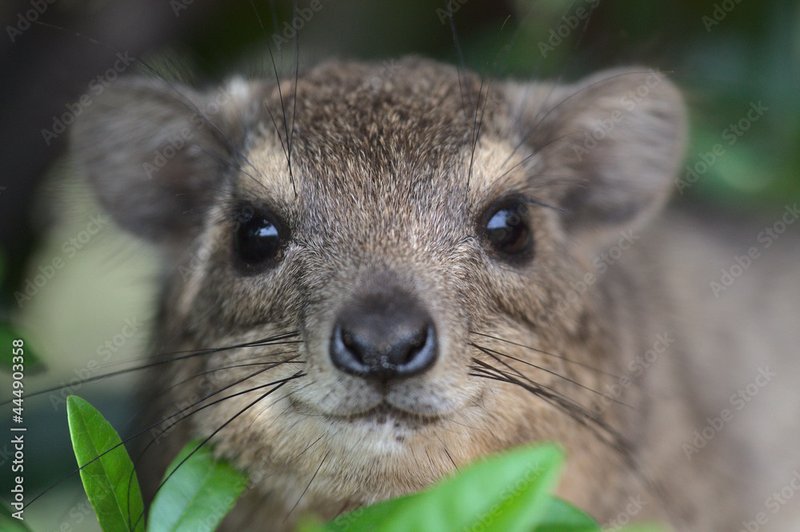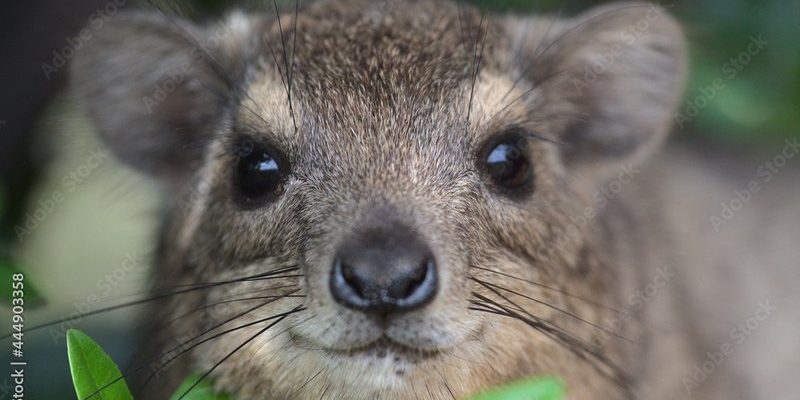
Imagine a furry little creature that looks like a mix between a rabbit and a miniature hippo—meet the hyrax. These quirky mammals, found mostly in Africa and parts of the Middle East, are surprisingly unique in the animal kingdom. Despite their small size, they belong to a rare group of mammals called herbivorous mammals. Their scientific name is Procavia capensis, but you might see them referred to as rock hyraxes or cape hyraxes. They typically weigh between 4 to 11 kg (about 9 to 24 pounds) and measure around 30 to 65 cm (about 12 to 26 inches) in length. Isn’t that interesting?
Hyraxes have a distinctive appearance, characterized by their short legs, rounded bodies, and large, protruding front teeth. You might be thinking, “What’s so special about that?” Well, here’s the thing: hyraxes are actually more closely related to elephants than they are to any rodent! This connection comes from their shared lineage that dates back millions of years. Understanding this relationship gives us insights into the evolutionary history of mammals, making the hyrax not just cute, but also a vital piece of nature’s puzzle.
Hyrax Habitat and Distribution
Hyraxes are fascinating creatures not only because of their lineage but also because of their habitats. They typically live in rocky outcrops, cliffs, and mountainous regions, where they can find adequate shelter from predators. You can spot them basking in the sun on warm rocks or nestled into crevices for safety. Their preference for rocky areas isn’t just about comfort; it’s also a clever survival tactic. These terrains provide easy escape routes and a good vantage point to spot approaching threats, like birds of prey or larger mammals.
In terms of distribution, hyraxes can be found in various regions across Africa, from the savannahs to bushlands, and even in some woodlands. Some species, like the rock hyrax, are more common in southern Africa, while others like the forest hyrax are found in the central and west regions. This range highlights their adaptability to different environments. When we look at their habitat, it becomes clear how integral they are to their ecosystems, aiding in plant growth and providing a food source for predators.
Diet and Feeding Habits
Hyraxes are primarily herbivores, which means their diet mainly consists of plant material. They love munching on a variety of vegetation, including leaves, grasses, fruits, and even tree bark. Given that hyraxes have a complex digestive system, they can effectively break down even tough, fibrous foods. This ability allows them to thrive in their natural habitats, where they search for tasty bites among the rocky outcrops and shrubs.
You might find it surprising that hyraxes have a habit of social eating. They often gather in groups, which not only helps them socialize but also allows for more efficient foraging. Being part of a group provides safety in numbers, making it easier to watch for predators while they munch away. What’s even more fascinating is their ability to regurgitate food and chew it again, a behavior known as rumination. This way, they maximize nutrient absorption from their meals.
Social Structure and Behavior
Social dynamics play a crucial role in the lives of hyraxes. These creatures are highly sociable animals, often living in groups called colonies. A colony can consist of anywhere from 10 to 80 individuals, depending on the species and environmental conditions. Within these groups, each hyrax has a specific role to play, from foraging for food to keeping watch for predators. This social structure offers not only safety but also enhances learning and the sharing of information about resources.
Their social interactions are charming to observe. They communicate through a range of vocalizations, from high-pitched calls to low grunts. These sounds help maintain group cohesion and alert others to potential threats. Additionally, hyraxes engage in grooming behaviors that promote bonding within the group. Grooming is essential for their social structure—think of it as a form of social currency, strengthening friendships and alliances through caring actions.
Reproduction and Lifespan
When it comes to reproduction, hyraxes have a fascinating cycle. Breeding typically occurs during the rainy season when food is abundant. Females give birth to one or two young after a gestation period of about 7 to 8 months. The newborns are precocial, meaning they can move around and eat solid food shortly after birth, which is critical for their survival in the wild. This is especially important because hyraxes are preyed upon by several other animals, and the quicker the young can adapt, the better their chances of survival.
In the wild, hyraxes can live up to 10 years, although they may face numerous threats from predators, habitat loss, and environmental changes. In captivity, where those threats are minimized, they can live a bit longer. Understanding their lifespan helps us appreciate the challenges hyraxes face in maintaining their population and the role they play in their ecosystems.
Conservation Status
Unfortunately, like many wildlife species, hyraxes face various threats. Their habitats are often destroyed due to urban development, agriculture, and mining. Additionally, hunting and poaching pose significant risks to their populations. Some species of hyrax are classified as vulnerable or endangered due to their decreasing numbers caused by these human activities. Conservation efforts are crucial in supporting their survival, focusing on protecting their habitats and educating local communities about the importance of preserving these unique animals.
Organizations working in animal conservation have taken steps to ensure that hyraxes and their habitats are safeguarded. By collaborating with local communities, they aim to foster a sense of stewardship towards wildlife. You might be surprised to learn that even small actions can make a big difference. By promoting ecotourism and responsible practices, communities can benefit economically while protecting their natural resources and the wildlife that inhabits them.
| Fact | Details |
| Size | 30 to 65 cm (12 to 26 inches) |
| Weight | 4 to 11 kg (9 to 24 pounds) |
| Diet | Herbivorous: leaves, fruits, and grasses |
| Lifespan | Up to 10 years in the wild |
| Habitat | Rocky outcrops, cliffs, and mountainous regions |
| Social Structure | Lives in colonies of 10 to 80 individuals |
Interesting Facts About Hyraxes
Hyraxes are loaded with quirks that make them stand out! Did you know that hyraxes have unique adaptations that allow them to thrive in their habitats? For instance, the structure of their feet helps them grip rocky surfaces, which is vital for their lifestyle. They have padded, flexible feet with nails that allow them to climb and navigate their steep, rocky environments effortlessly. This adaptation is a perfect example of how nature equips animals to survive in the wild.
Another fun fact is that hyraxes have a distinctive way of regulating their body temperature. Unlike most mammals that rely solely on metabolic processes, hyraxes use behavioral means. They bask in the sun to warm up during the chilly nights and retreat to cool, shaded areas during the heat of the day. This ability to adapt to temperature fluctuations is crucial for their survival, especially in regions with extreme weather conditions.
FAQ
Are hyraxes dangerous to humans?
Hyraxes are generally not dangerous to humans. They are shy and prefer to avoid confrontations. Although they can bite if threatened, they pose little risk. Their main concern is their safety from predators rather than interactions with humans. Most people see them as interesting creatures rather than threats.
How do hyraxes communicate with each other?
Hyraxes communicate through a variety of vocalizations, such as whistles, grunts, and barks. These sounds help them convey messages about danger or to coordinate movements within their group. Social behaviors like grooming also play a key role in their communication, reinforcing bonds and ensuring group harmony.
Can hyraxes swim?
While hyraxes are primarily terrestrial creatures, they can swim if necessary. They tend to avoid water but can paddle through it when needed. However, their preferred habitats are not typically near large water bodies, so swimming isn’t a common behavior for them.
What do hyraxes do during the day?
Hyraxes are diurnal, meaning they are active during the day. They spend their time foraging for food, basking in the sun, and socializing with their colony members. This activity peaks in the morning and late afternoon when temperatures are cooler and food is plentiful.
Why are hyraxes considered a keystone species?
Hyraxes are considered a keystone species because their activities help maintain the structure of their ecosystem. Their foraging habits affect plant growth, which in turn provides food and shelter for other wildlife. By keeping plant populations in check, they help sustain biodiversity in their habitats.
How can I help protect hyraxes?
You can help protect hyraxes by supporting conservation efforts and educating yourself and others about their importance. Participating in responsible tourism and choosing eco-friendly products can also contribute to their habitat’s preservation. Every small action counts, whether it’s spreading awareness or supporting local conservation organizations.
What is the conservation status of hyraxes?
The conservation status of hyraxes varies among different species. While some are abundant and stable, others are classified as vulnerable or endangered due to habitat loss and hunting. Conservation initiatives aim to protect their populations and raise awareness about their plight, emphasizing the importance of preserving their habitats.

